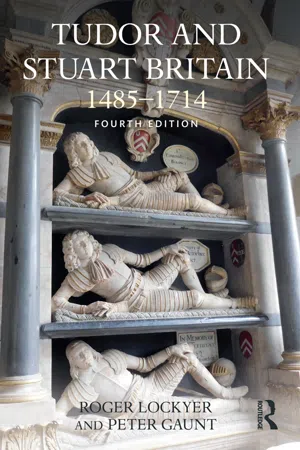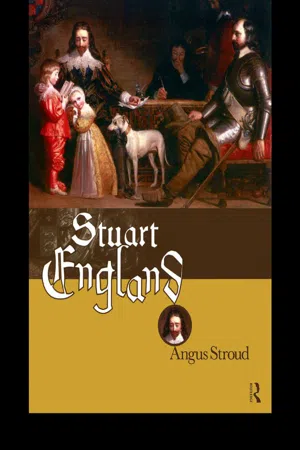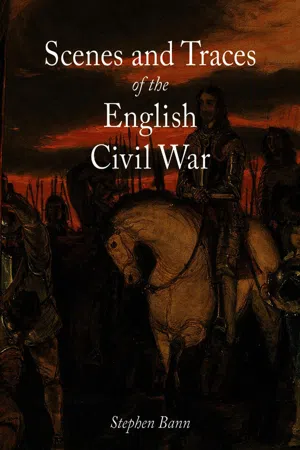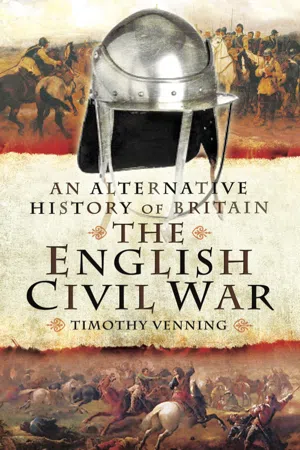Battle of Worcester
The Battle of Worcester took place on September 3, 1651, during the English Civil War. It was the final battle of the war, resulting in a decisive victory for the Parliamentarian forces led by Oliver Cromwell over the Royalist army of King Charles II. The defeat led to the end of the Royalist cause and the exile of Charles II.
5 Key excerpts on "Battle of Worcester"
- eBook - ePub
Tudor and Stuart Britain
1485-1714
- Roger Lockyer, Peter Gaunt(Authors)
- 2018(Publication Date)
- Routledge(Publisher)
...Such divisions and the popular wartime allegiances to which they might have given rise can be discerned in Warwickshire and much of the South-West – in Wiltshire, Somerset, Dorset, parts of Gloucestershire and perhaps, in a more complex way and involving other factors, in Devon – but it does not seem to work in other parts of England or in Wales, where pasture-type farming dominated, with large parishes, a thin and dispersed population and few towns, yet popular royalism clearly held sway there. Civil war By autumn 1642 Charles had an army of around 6,000 foot and 3,500 horse and was ready to strike at London, the nerve centre of his enemies. Having moved westwards from Nottingham and based himself for several weeks in Shrewsbury, better to rendezvous with the large number of recruits raised in Wales and the central Marches, in mid-October he left Shrewsbury and moved south-east towards the capital. With him was his 23-year-old nephew, Rupert, one of the sons of the Winter Queen, who had come to England to fight for him. The Earl of Essex, who had been appointed by the two Houses to command the parliamentarian forces, had marched out from London to meet the King, crossing the southern Midlands and occupying Worcester during the last week of September. Hearing that the King had left Shrewsbury, in mid-October he marched out, a little tardily, to engage Charles’s army as it was advancing south-eastwards and the two armies clashed at Edgehill in south Warwickshire, a little north of Banbury in Oxfordshire, on 23 October. In this first engagement of the war the pattern was set for many of the later encounters. Rupert’s cavalry, on one wing, charged right through their opponents and disappeared into the distance. But the parliamentarian cavalry on the other wing broke the royalist line and (temporarily) captured the King’s standard...
- eBook - ePub
- Angus Stroud(Author)
- 2002(Publication Date)
- Routledge(Publisher)
...He was intercepted by the main Parliamentarian army under the leadership of the Earl of Essex at Edgehill, where the first battle of the Civil War was fought on 23 October 1642. It was an indecisive and confused affair, but could be considered a victory of sorts for the King, as Essex’s withdrawal from the battlefield overnight left his path open to continue the advance on London. By November, the Royalists had been halted on the outskirts of London, at Turnham Green, by Essex’s forces, supplemented by the London militia, and the King retreated to Oxford, where he established his future headquarters. The winter of 1642–3 saw a renewed attempt at negotiations between the two sides, largely as a result of the insistence of the peace party in Parliament. Dismayed at the bloodshed of the autumn, moderates were desperate to reach a peaceful settlement with the King, a sentiment heightened by the fact that London was now cut off from its coal supply in the north-east. Parliamentary commissioners spent over two months in Oxford, but any hopes for a deal foundered on the continuing differences over Church reform and control of the Crown’s ministers; and on Charles’s reluctance to commit himself to the terms of any treaty, while there was any hope of his military position improving. 1643 The spring and summer of 1643 was the period during which the King and his forces enjoyed their greatest success, and came the closest to being able to enforce a military solution. The Kings forces enjoyed a string of victories, and seemed to threaten a three-pronged advance on London. The northern army, under the Earl of Newcastle, had captured Yorkshire by defeating the parliamentary forces under the Fairfaxes, at Adwalton Moor, and was poised to march south...
- eBook - ePub
- Stephen Bann(Author)
- 2020(Publication Date)
- Reaktion Books(Publisher)
...3). While it does take the controversial figure of Herbert at his own valuation, this notice also brings to mind the historiographical aspect in the transmission of Civil War memories. By the early nineteenth century, Herbert’s published testimony was frequently quoted in historical accounts of the last weeks leading up to the king’s execution. He is represented in person as the thoughtful witness who surveys the scene in Delaroche’s painting of Charles I Insulted by the Soldiers of Cromwell (1837), which will be the subject of a later chapter. For the most part, these contemporary plaques that are to be seen throughout the country defer to local sentiment without adopting a strongly adversarial point of view. The closest to outright celebration, in this very limited survey, would be the inscription on the bridge at Worcester that commemorates Cromwell’s crushing victory over the future Charles II at the Battle of Worcester in 1651 (illus. 4). This gains its emotional effect through quoting, and capitalizing, the Lord Protector’s famous exclamation: ‘ IT IS FOR AUGHT I KNOW A CROWNING MERCY.’ Erected as late as 1993, and jointly subsidized by the Cromwell Association, Worcester City Council and a public subscription, this obviously justifies its prominence in the city that provided the focus for a unique Civil War narrative: not just the victory of Cromwell over the Stuart heir to the throne with his predominantly Scottish army, but the picaresque episode of the escape of the future Charles II. As I shall show in a later chapter, the first and foremost feature of the Civil War to be pictured and described, apart from the execution of Charles I, was the tale of the younger Charles, who was still a boy at its inception: of his hiding in the Boscobel oak and sundry other adventures that culminated in his eventual flight to France. Worcester displays the whole spectrum of this history in an enterprising museum that bears the traditional name of ‘The Commandery’...
- eBook - ePub
- Peter Newman(Author)
- 2020(Publication Date)
- Routledge(Publisher)
...MAP 50 & 51 The Battle of Worcester, 3 September 1651 Cromwell’s main body lay to the south-east of the city on and around the Red Hill, on the east bank of the Severn, whilst Fleetwood was moving from Upton along the road to Powick and so to Powick Bridge, scene of a royalist cavalry victory in 1642. Fleetwood’s objective was to cross the River Teme and attack the Scots on its northern bank, who formed the western defences of the city. The troops under Fleetwood moved slowly, but came to the Teme at two points, near Powick Bridge itself and further to the east at the bridge of boats across the Teme near that river’s confluence with the Severn. To add to Fleetwood’s impact, Cromwell sent large numbers of his own cavalry across the Severn to reinforce the other column, and in late afternoon Fleetwood forced the crossing of the Teme at both points and ran into heavy resistance from the Scottish forces to its north. From the vantage point of the cathedral tower, the royalist commanders could see the fighting going on to the west, and see also the Scots progressively falling back on the city. They could also see that Cromwell had despatched the bulk of his horse to assist Fleetwood, and Charles determined to use his own cavalry in a frontal assault on Cromwell’s position, under the covering fire of the artillery in Fort Royal. In a sense, this attack was forced upon the King by the failure of David Leslie, established north-west of the city, to move his forces in to assist his fellow Scots against Fleetwood, forcing Charles to try the diversionary tactic. Leaving the city by the Sudbury Gate, the royalist troops moved up the London Road towards Red Hill, whilst another column under the duke of Hamilton advanced on Perry Wood. Hamilton’s men swept forward over all resistance, seized the enemy guns around Perry Wood, and gained their position, whilst the King’s forces had a similar success at Red Hill...
- eBook - ePub
- Timothy Venning(Author)
- 2015(Publication Date)
- Pen & Sword Military(Publisher)
...Chapter Four Was the War Winnable in 1644 – by the King, or by Parliament without Resorting to the Creation of the New Model Army? Strategy in spring–summer 1644: did the King throw away a strong position? Did the Parliamentarians fail to follow up major opportunities? The situation after the Newbury campaign: military stalemate? Two royalist reverses, in the south and north The effective stalemate produced by the King’s failures at Gloucester and Newbury in 1643 was in danger of producing a long war. Neither of the two central armies – the King’s at Oxford or Essex’s at London – was able to defeat the other, with their comparatively equal sizes and fire-power matched by cautious generalship. In the other theatres of war, the situation was complicated by local allegiances at variance with the prevailing loyalties of an area and isolated garrisons, too strong to be stormed or starved out except by major effort, in towns and fortified houses. The royalists held almost all the west and south-west with Wales, apart from isolated towns – most on the coast (e.g. Plymouth and Lyme Regis) but a few inland (Gloucester being on a useable river, Taunton not so). The Parliamentarians held the south-east from Hampshire to Kent, with East Anglia and most of the East Midlands, and had the most disciplined and coherent of the local armies in that of the Eastern Association whose control extended as far north as the Trent. They also had the most effective strategist produced by the war so far, Sir William Waller, in command of the local Parliamentarian army in the south and put in charge of a new South-Eastern Association in December; this bonus for Parliament, however, followed Essex haughtily insisting that Waller had to give up his recent independent commission and become his subordinate again...




